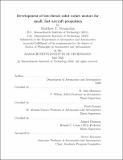| dc.contributor.advisor | R. John Hansman, Paulo Lozano and Ahmed Ghoniem. | en_US |
| dc.contributor.author | Vernacchia, Matthew T. | en_US |
| dc.contributor.other | Massachusetts Institute of Technology. Department of Aeronautics and Astronautics. | en_US |
| dc.date.accessioned | 2020-09-03T17:45:26Z | |
| dc.date.available | 2020-09-03T17:45:26Z | |
| dc.date.copyright | 2020 | en_US |
| dc.date.issued | 2020 | en_US |
| dc.identifier.uri | https://hdl.handle.net/1721.1/127069 | |
| dc.description | Thesis: Ph. D., Massachusetts Institute of Technology, Department of Aeronautics and Astronautics, May, 2020 | en_US |
| dc.description | Cataloged from the official PDF of thesis. | en_US |
| dc.description | Includes bibliographical references (pages 281-289). | en_US |
| dc.description.abstract | Small, uncrewed aerial vehicles (UAVs) are expanding the capabilities of aircraft systems. However, a gap exists in the size and capability of aircraft: no small aircraft are capable of sustained fast flight. A small, fast aircraft requires a propulsion system which is both miniature and high-power, requirements which current UAV propulsion technologies do not meet. Solid propellant rocket motors could be used, but must be re-engineered to operate at much lower thrust and for much longer burn times than conventional small solid rocket motors. This imposes unique demands on the motor and propellant. This work investigates technological challenges of small, low-thrust solid rocket motors: slow-burn solid propellants, motors which have low thrust relative to their size (and thus have low chamber pressure), thermal protection for the motor case, and small nozzles which can withstand long burn times. | en_US |
| dc.description.abstract | Slow-burn propellants were developed using ammonium perchlorate oxidizer and the burn rate suppressant oxamide. By varying the amount of oxamide (from 0-20%), burn rates from 4mms⁻¹ to 1mms⁻¹ (at 1MPa) were achieved. Using these propellants, a low-thrust motor successfully operated at a (thrust / burn area) ratio 10 times less than that of typical solid rocket motors. This motor can provide 5-10N of thrust for 1-3 minutes. An ablative thermal protection liner was tested in these firings. Despite the long burn time, only a few millimeters of ablative are needed. A new ceramic-insulated nozzle was demonstrated on this motor. The nozzle has a small throat diameter (only a few millimeters) and can operate in thermal steady-state. Models were developed for the propellant burn rate, motor design, heat transfer within the motor and nozzle, and for thermal stresses in the nozzle insulation. | en_US |
| dc.description.abstract | This work shows that small, low-thrust solid motors are feasible, by demonstrating these key technologies in a prototype motor. Further, the experimental results and models will enable engineers to design and predict the performance of solid rocket motors for small, fast aircraft. By providing insight into the physics of these motors, this thesis may help to enable a new option for aircraft propulsion. | en_US |
| dc.description.statementofresponsibility | by Matthew T. Vernacchia. | en_US |
| dc.format.extent | 289 pages | en_US |
| dc.language.iso | eng | en_US |
| dc.publisher | Massachusetts Institute of Technology | en_US |
| dc.rights | MIT theses may be protected by copyright. Please reuse MIT thesis content according to the MIT Libraries Permissions Policy, which is available through the URL provided. | en_US |
| dc.rights.uri | http://dspace.mit.edu/handle/1721.1/7582 | en_US |
| dc.subject | Aeronautics and Astronautics. | en_US |
| dc.title | Development of low-thrust solid rocket motors for small, fast aircraft propulsion | en_US |
| dc.type | Thesis | en_US |
| dc.description.degree | Ph. D. | en_US |
| dc.contributor.department | Massachusetts Institute of Technology. Department of Aeronautics and Astronautics | en_US |
| dc.identifier.oclc | 1191819173 | en_US |
| dc.description.collection | Ph.D. Massachusetts Institute of Technology, Department of Aeronautics and Astronautics | en_US |
| dspace.imported | 2020-09-03T17:45:26Z | en_US |
| mit.thesis.degree | Doctoral | en_US |
| mit.thesis.department | Aero | en_US |
